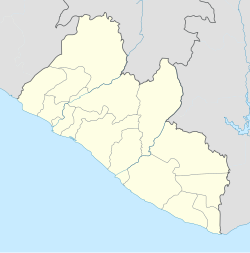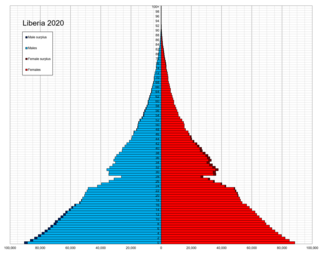
As of 2006, Liberia had the highest population growth rate in the world. This has declined since, however, and stood at 2.37 percent in 2023.

Monrovia is the capital city of the West African country of Liberia. Founded in 1822, it is located on Cape Mesurado on the Atlantic coast and as of the 2022 census had 1,761,032 residents, home to 33.5% of Liberia’s total population. Its Metro Area including Montserrado and Margibi counties largely being urbanized, was home to 2,225,911 inhabtants as of the 2022 census. As the nation's primate city, Monrovia is the country's economic, financial and cultural center; its economy is primarily centered on its harbor and its role as the seat of Liberian government.

Montserrado County is a county in the northwestern portion of the West African nation of Liberia containing its national capital, Monrovia. One of 15 counties that comprise the first-level of administrative division in the nation, it has 17 sub political districts. As of the 2022 Census, it had a population of 1,920,914, making it the most populous county in Liberia. The area of the county measures 738.5 square miles (1,913 km2), the smallest in the country. Bensonville serves as the capital.

Guinée forestière is a forested mountainous region in southeastern Guinea, extending into northeastern Sierra Leone. It is one of four natural regions into which Guinea is divided and covers 23% of the country. It includes all of the Nzérékoré administrative region, and shares a border with Sierra Leone and Liberia. Its rocky topology contains several mountain ranges and has an average elevation of 460m. Forested Guinea contains important areas of biological diversity such as the UNESCO World Heritage site Mount Nimba Strict Nature Reserve and biosphere reserve Ziama Massif. The Guéckédou prefectures also recorded the initial case of the 2014 Ebola outbreak in Meliandou, a rural village. The virus subsequently spread to urban areas and neighbouring countries Sierra Leone and Liberia.
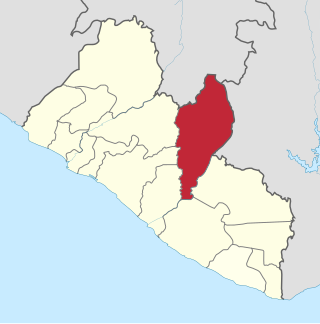
Nimba County is a county in northeastern Liberia that shares borders with the Republic of Côte d'Ivoire in the East and the Republic of Guinea in the Northwest. Its capital city is Sanniquellie and its most populous city is Ganta. With the county's area measuring 11,551 square miles (29,920 km2), Nimba is the largest of Liberia's 15 counties. The county has six statutory districts. As of the 2022 Census, it had a population of 621,841, making it the second most populous county in Liberia.
Zorzor is the second largest city in Lofa County, Liberia. Located far from Liberia's capital of Monrovia, it is a local trade center for agricultural products such as rice, cassava, pineapples, palm oil, and palm kernels. Zorzor's major ethnic groups include the Kpelle and Loma peoples. The town also contains an American Lutheran church hospital, a leper colony, and a handicrafts workshop. The Zozor Rural Teacher Training institute is located in the nearby town of Fisebu. Without motorised transport, Zorzor is approximately seven days' walk away from Monrovia. The city's first hospital was the aforementioned Lutheran facility, which was constructed in 1924; local residents were initially suspicious of Western medicinal practices, but they were ultimately convinced by thirty-one years of labor by Esther Bacon, an American nurse who worked at the hospital from 1941 until her 1972 death.
Yomou is a town located in southeastern Guinea. It is the capital of Yomou Prefecture. It has an estimated population of 29,138 (2008) growing from 9,661 (1996).
The Gola or Gula are a West African ethnic group who share a common cultural heritage, language and history and who live primarily in western/northwestern Liberia and Eastern Sierra Leone. The Gola language is an isolate within the Niger–Congo language family. As of 2015, it is spoken by about 278,000 people.
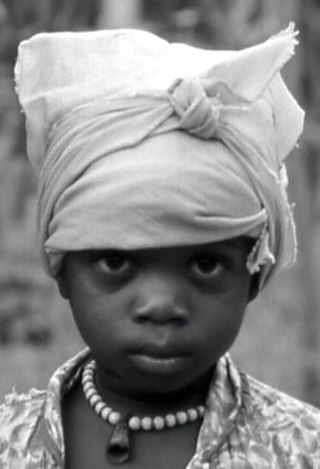
The Kpelle people are the largest ethnic group in Liberia. They are located primarily in an area of central Liberia, extending into Guinea. They speak the Kpelle language, which belongs to the Mande language family.

Zorzor District is one of six districts located in Lofa County, Liberia. Zorzor is the principal city of the county. The district is home to the city of Zorzor which serves as a prominent local trading hub for agricultural commodities like rice, cassava, pineapples, palm oil, and palm kernels. Within Zorzor, the predominant ethnic groups are the Kpelle and Loma peoples.
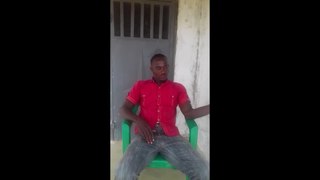
The Kpelle language is spoken by the Kpelle people of Liberia, Guinea and Ivory Coast and is part of the Mande language family. Guinean Kpelle, spoken by half a million people, is concentrated primarily, but not exclusively, in the southeastern forest regions of Guinea bordering Liberia, Ivory Coast, and Sierra Leone. Half a million Liberians speak Liberian Kpelle, which is taught in Liberian schools.
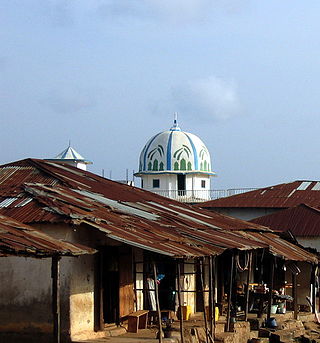
Islam in Liberia is practiced by an estimated 12.2% of the population. The vast majority of Liberian Muslims are Malikite Sunni, with sizeable Shia and Ahmadiyya minorities. The primary Muslim ethnic groups are the Vai and Mandingo but also Gbandi, Kpelle and other ethnic groups. Historically, Liberian Muslims have followed a relaxed and liberal form of Islam that is heavily influenced by indigenous religions that were integrated into Islam when it came to Liberia in the 16th century with the collapse of the Songhai Empire in Mali. Islamic religious practices vary in cities and towns across the country. Younger Liberian Muslims, particularly in the cities along the coast, tend to be more secular but still practice Islam in everyday life. In rural areas, Liberian Muslims are more conservative in dressing modestly, performing prayers and attending religious studies. The practice of Islam in Liberia has been compared to Islam common in Senegal and Gambia, with strong orientation toward Sufism.
The Kpelle syllabary was invented c. 1935 by Chief Gbili of Sanoyie, Liberia. It was intended for writing the Kpelle language, a member of the Mande group of Niger-Congo languages spoken by about 490,000 people in Liberia and around 300,000 people in Guinea at that time.
Liberian Americans are an ethnic group of Americans of full or partial Liberian ancestry. This can include Liberians who are descendants of Americo-Liberian people in America. The first wave of Liberians to the United States, after the slavery period, was after of the First Liberian Civil War in the 1990s and, then, after the Second Liberian Civil War in the early 2000s.
Christianity is the predominant religion in Liberia, with Protestantism being its largest denomination. Liberia is a secular state and its constitution guarantees freedom of religion. While most Liberians have religious affiliations, traditional belief systems are widespread.

The Guinea Highlands is a densely forested mountainous plateau extending from central Guinea through northern Sierra Leone and Liberia to western Ivory Coast. The highlands include a number of mountains, ranges and plateaus, including the Fouta Djallon highlands in central Guinea, the Loma Mountains in Sierra Leone, the Simandou and Kourandou massifs in southeastern Guinea, the Nimba Range at the border of Guinea, Liberia, and Ivory Coast, and the Monts du Toura in western Ivory Coast.
Kwi is a Liberian term used to connote Westernization, adherence to Christianity, a Westernized first name and surname, literacy through a Western-style education, and adherence to a cash economy instead of a subsistence economy, regardless of an individual's ethnic origin. However, it has historically denoted strong adherence to Americo-Liberian cultural norms, although one need not identify as ethnically Americo-Liberian in order to be kwi.
Joseph Nargba Cooper was a Liberian politician from Bong County who held office in the third quarter of the twentieth century. Born on 16 August 1918 in the town of Gbaudi in Zorzor District, Lofa County, he was the son of Porkpa Womma and Nowai Gbanasei. After receiving his early education in a Lutheran school at Zorzor, Cooper left in 1933 to follow his brother Charlie to Kakata, where he finished his education at a Catholic mission school. Having completed his schooling, Cooper entered the employ of the Firestone Plantation Company; here he worked until 1944, when the government hired him to become a chauffeur for President Tubman. Later in his government service, Cooper was the Native Advocate for the Central Province. In 1967, Cooper was elected to fill one of Bong County's seats in the House of Representatives; he continued to occupy this office until his death, which occurred in a Bong County hospital on 22 May 1975. From 29 January 1950 until his death, Cooper was married to the former Emma L. Jensen, a native of Sanoyie; they had four sons and four daughters. As an adult, Cooper was affiliated with the Lutheran church.
The Southwestern Mande languages are a branch of the Mande languages spoken in Sierra Leone, Guinea, and Liberia. There are around 2.8 million total speakers. The largest languages by far are Mende of Sierra Leone, with 1.4 million, and Kpelle of Liberia and Guinea, with 1.2 million.
Suah Koko was an indigenous Liberian ruler who lived between the late 19th and early 20th century. She fought several battles against the expansionary Liberia Frontier Force before entering negotiations to grant accession of the territory she ruled over to the Liberian government. She later became a paramount chief and supplied porters to the Harvard Medical African Expedition (1926–1927).
